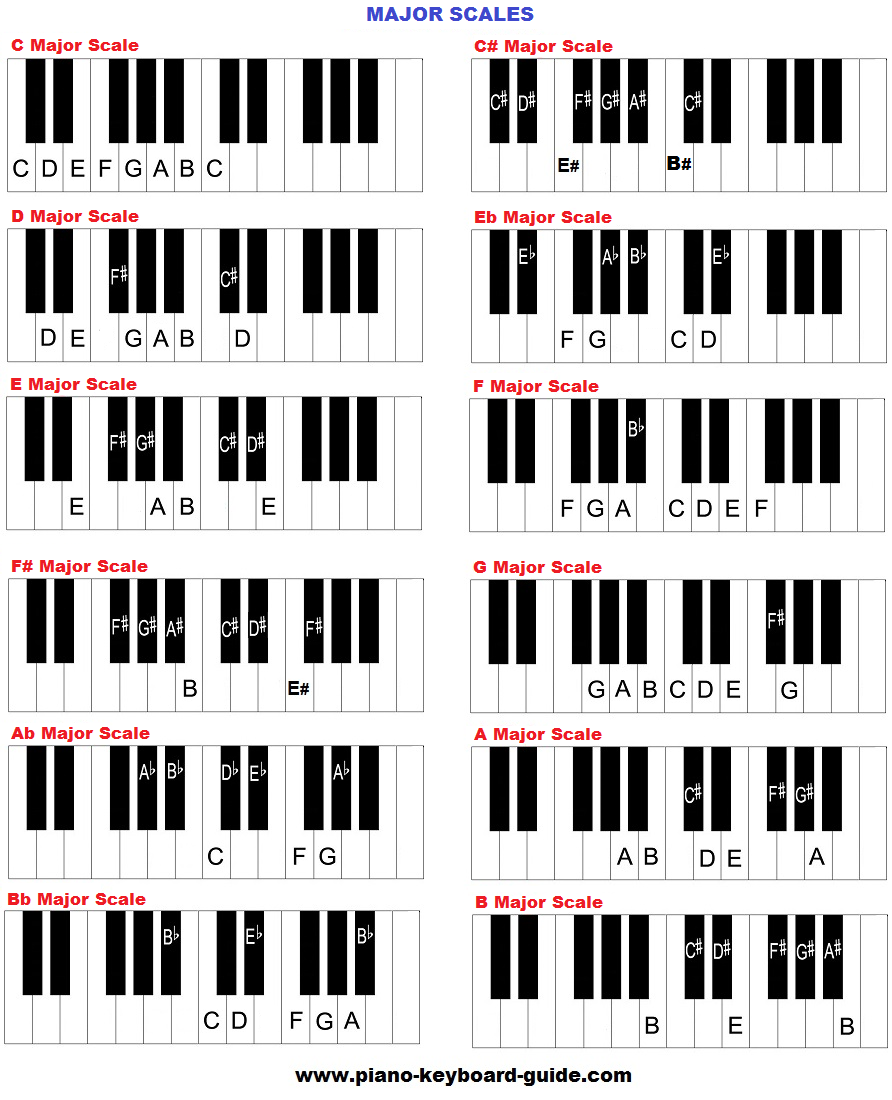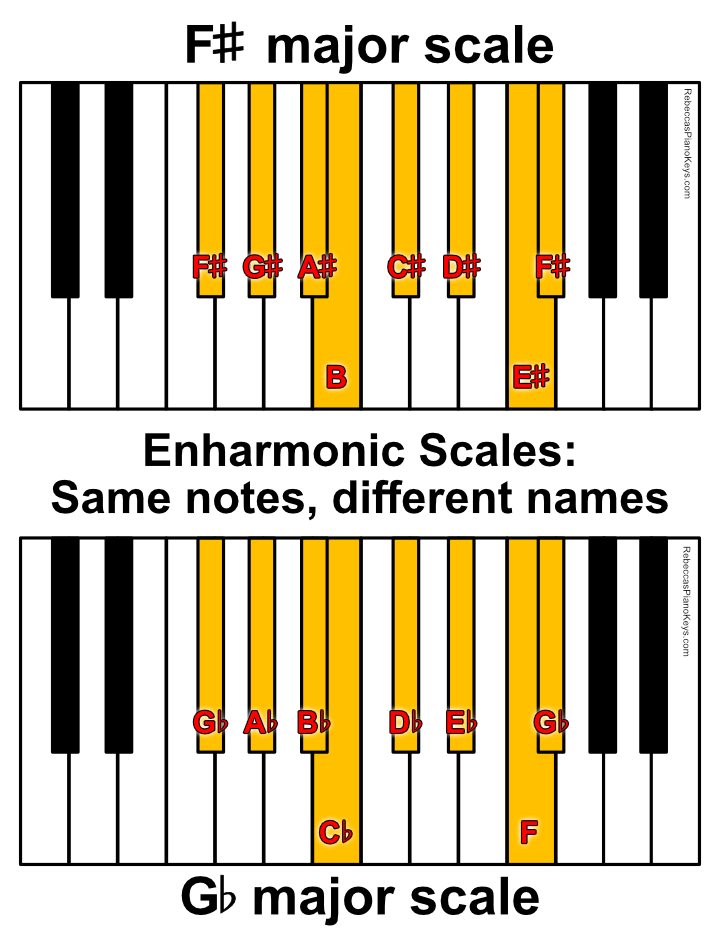Piano scales are sequences of notes played in ascending and descending order on a keyboard. They form the foundation for melody, harmony, and finger technique in piano playing.
Mastering piano scales is vital for anyone learning to play the piano. These scales are not just a series of notes; they provide a framework for understanding musical structure and developing dexterity. Aspiring pianists practice scales to improve their hand coordination, strengthen fingers, and familiarize themselves with key signatures.
Engaging with scales also enhances a musician’s ability to improvise and compose, making them an essential tool for performance and examination preparation. The study of scales can be seen as the building blocks for further musical education, laying the groundwork for more advanced pieces and styles of music. They are as critical for beginners grasping the basics as they are for seasoned players striving to refine their technique.

Credit: www.piano-keyboard-guide.com
The Essence Of Piano Scales
Exploring the world of piano music, understanding piano scales is key. These scales form the backbone of melodies and harmonies that create beautiful music. Now, let’s dive into the essential aspects of piano scales.
Building Blocks Of Music
Piano scales are much more than a series of notes. They are the fundamental components from which music is built. Think of them as the ABCs of music language. Knowing scales helps musicians understand the framework of songs.
- Major scales bring a sense of happiness and brightness.
- Minor scales often convey a more somber or introspective mood.
Scales also lay the groundwork for creating music’s tension and release, an essential part of storytelling through sound.
The Role In Piano Mastery
For pianists, scale practice is vital for skill development. By mastering scales, pianists gain:
| Area of Improvement | Benefits of Scale Practice |
|---|---|
| Technique | Enhanced finger dexterity and coordination. |
| Ear Training | Improved ability to recognize and replicate pitches. |
| Music Theory | Deeper understanding of harmonic and melodic structures. |
| Improvisation | Greater freedom to create spontaneous melodies. |
Through diligent scale practice, pianists can hone their craft and express music with precision and emotion.

Credit: www.hoffmanacademy.com
Diving Into Types Of Scales
Piano scales form the foundation of music creation and understanding. They help musicians grasp the logic behind melody and harmony. With a little knowledge and practice, mastering scales enriches the playing experience. Let’s explore the different types of scales each pianist should know.
Major And Minor Scales
Major scales sound bright and happy. They follow a specific pattern of whole and half steps. Start from any note and use this pattern: whole, whole, half, whole, whole, whole, half.
Minor scales have a different vibe, often sounding sad or serious. There are three types of minor scales: natural, harmonic, and melodic. Each has its own unique step pattern, affecting the scale’s mood and feel.
- Natural Minor: Follows this pattern: whole, half, whole, whole, half, whole, whole.
- Harmonic Minor: Changes one note from the natural minor to create a distinct sound.
- Melodic Minor: Ascends with one pattern and descends with the natural minor pattern.
Chromatic And Whole Tone Variations
Chromatic scales are made of half steps only. Play every key in sequence, black and white, and you’ve got a chromatic scale. It’s like climbing stairs, one small step at a time.
Whole tone scales take a different approach. This scale consists of whole steps only. It creates a dreamy and unanchored sound, as there’s no clear beginning or end.
| Scale Type | Step Pattern | Sound Characteristic |
|---|---|---|
| Chromatic | Half steps only | Climbing steps |
| Whole Tone | Whole steps only | Dreamy, endless |
Technical Benefits For Pianists
Mastering the piano involves much more than playing songs. For serious pianists, scales are essential. They offer a world of technical benefits. Scales help musicians understand the piano better. They improve playing skills. Here’s how they can bolster a pianist’s ability:
Finger Strength And Dexterity
Finger strength is crucial for pianists. Regular scale practice builds this strength. It trains hands for complex pieces. With scales, each finger gets a workout. This leads to improved dexterity. Pianists can play faster and more smoothly. Scales involve repetition. This repetition enhances muscle memory. Strong, agile fingers are the result. The following points explain scale benefits for finger fitness:
- Steady practice boosts finger endurance.
- Varied scales develop agility across different keys.
- Slow, deliberate play strengthens weaker fingers.
Understanding Key Signatures
Scales are musical foundations. They teach pianists about key signatures. Why is this important? It’s simple. Each scale provides the blueprint for a key. Knowing scales means recognizing patterns on the keyboard. Pianists learn to anticipate notes in each key. This knowledge is powerful. It makes learning new music faster. Sight-reading becomes easier. The table below shows the relationship between scales and keys:
| Scale | Key Signature |
|---|---|
| C Major | No sharps or flats |
| G Major | F# |
| D Major | F# and C# |
By practicing scales, pianists build a mental map of keys. They easily recognize the scale patterns in compositions. This deep understanding aids in improvisation and composition too.
Practical Applications In Compositions
Understanding piano scales is key to unlocking the musical language. But why are they so important when composing music? Let’s delve into how scales give life to melodies and harmonies within compositions.
Scales In Melodic Construction
Composers use scales to weave the fabric of a tune. Think of scales as a painter’s palette — a source of various notes that create melodies. They are the backbone of musical themes and motifs.
- Scales determine the mood — major scales often sound happy, while minor scales bring a more somber tone.
- They add character to tunes — using blues or exotic scales for unique flavors.
- Patterns from scales help create memorable hooks that catch the listener’s ear.
Harmonic Foundations And Progressions
Apart from melody, harmony is the pillar of music. Scales shape chords and the progression of a composition.
- Chords are stacked notes from scales which provide a song’s structure.
- Scales guide chord progression — the sequence that supports the melody.
- Understanding scales allows composers to craft emotional journeys through shifting harmonies.
Incorporating Scales Into Practice Routines
Incorporating scales into practice routines is a cornerstone of mastering the piano. Scales are not just a series of notes. They build hand coordination, finger strength, and musical understanding. Integrating scales into daily practices can transform your piano playing.
Effective Warm-up Exercises
Using piano scales as warm-up exercises prepares fingers for more complex pieces. Begin with simple scales to loosen up the fingers. Move gradually to more challenging variations.
- Start slow: Play each scale note with attention to form.
- Use a metronome: Keep timing consistent and gradually increase the speed.
- Apply dynamics: Practice playing scales softly and loudly.
Advanced Scale Patterns And Speed Drills
For seasoned pianists, advanced patterns elevate scale practice. Incorporating speed drills refines agility and precision.
- Explore different fingerings for each scale.
- Play octave jumps within scales to improve hand positioning.
- Alternate rhythms challenge timing and articulation.
Track progress with a practice log. Note tempos and difficulties to overcome.

Credit: rebeccaspianokeys.com
Why are Piano Scales Important to Learn?
Piano scales are the foundation of music theory and essential for mastering the piano. The importance of piano scales lies in their ability to improve finger dexterity, technique, and understanding of music structure. Learning scales also enhances coordination and speed, making it crucial for any aspiring pianist to practice them regularly.
Frequently Asked Questions For What Are Piano Scales
What Are Scales In Piano Used For?
Piano scales form the foundation for understanding music theory, improving finger technique, and building dexterity. They also aid in learning key signatures and facilitate improvisation.
What Scales Should I Learn First Piano?
Begin with the C Major scale, as it has no sharps or flats. Next, learn G Major, with one sharp, followed by F Major, with one flat. These scales lay the foundation for piano proficiency.
What Is The Difference Between A Scale And A Chord On A Piano?
A scale on a piano consists of sequential notes in a specific key, while a chord is a group of usually three or more notes played simultaneously. Scales provide the foundation for melodies, whereas chords support harmony.
What Are The 12 Scales Of The Keyboard?
There are 12 major scales on the keyboard: C, C#, D, D#, E, F, F#, G, G#, A, A#, and B. Each scale corresponds to a series of whole and half-step patterns.
Conclusion
Mastering piano scales is more than just a technical necessity; it’s a musical liberation. Embracing these patterns equips you with a foundation for improvisation, composition, and a deeper connection to your instrument. So, sit at your piano, practice diligently, and let the scales guide your journey through the world of music.
With each note, you’re unlocking the language of the piano—one scale at a time.
{ “@context”: “https://schema.org”, “@type”: “FAQPage”, “mainEntity”: [ { “@type”: “Question”, “name”: “What are scales in piano used for?”, “acceptedAnswer”: { “@type”: “Answer”, “text”: “Piano scales form the foundation for understanding music theory, improving finger technique, and building dexterity. They also aid in learning key signatures and facilitate improvisation.” } } , { “@type”: “Question”, “name”: “What scales should I learn first piano?”, “acceptedAnswer”: { “@type”: “Answer”, “text”: “Begin with the C Major scale, as it has no sharps or flats. Next, learn G Major, with one sharp, followed by F Major, with one flat. These scales lay the foundation for piano proficiency.” } } , { “@type”: “Question”, “name”: “What is the difference between a scale and a chord on a piano?”, “acceptedAnswer”: { “@type”: “Answer”, “text”: “A scale on a piano consists of sequential notes in a specific key, while a chord is a group of usually three or more notes played simultaneously. Scales provide the foundation for melodies, whereas chords support harmony.” } } , { “@type”: “Question”, “name”: “What are the 12 scales of the keyboard?”, “acceptedAnswer”: { “@type”: “Answer”, “text”: “There are 12 major scales on the keyboard: C, C#, D, D#, E, F, F#, G, G#, A, A#, and B. Each scale corresponds to a series of whole and half-step patterns.” } } ] }